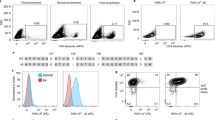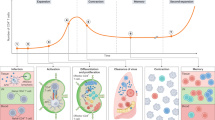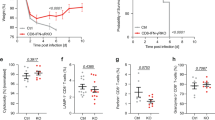Abstract
Recently activated, but not resting, CD4+ T cells express CD154, providing costimulatory signals to B cells and antigen-presenting cells (APCs). Therefore, de novo CD154 expression after stimulation identifies antigen-specific CD4+ T cells. Previous assays were limited by the transient nature of surface CD154 expression; we overcame this by including fluorescently conjugated CD154-specific antibody during stimulation. Our assay is fully compatible with intracellular cytokine staining, and can be used for stimulations as long as 24 h. Notably, it is nonlethal, providing a means to purify viable antigen-specific CD4+ T cells for further analysis. Using this assay, we found that stimulated cells expressing tumor necrosis factor (TNF)-α, interleukin (IL)-2 or interferon (IFN)-γ were predominantly CD154+. Furthermore, some cells expressing none of these cytokines also expressed CD154, suggesting that CD154 marks cells with other effector functions. For vaccine- or pathogen-specific responses, we found substantial heterogeneity in expression of CD154 and cytokines, suggesting previously unrecognized diversity in abilities of responding cells to stimulate APCs through CD40.
This is a preview of subscription content, access via your institution
Access options
Subscribe to this journal
Receive 12 print issues and online access
$209.00 per year
only $17.42 per issue
Buy this article
- Purchase on Springer Link
- Instant access to full article PDF
Prices may be subject to local taxes which are calculated during checkout




Similar content being viewed by others
References
Lyerly, H.K. Quantitating cellular immune responses to cancer vaccines. Semin. Oncol. 30, 9–16 (2003).
Maino, V.C. & Picker, L.J. Identification of functional subsets by flow cytometry: intracellular detection of cytokine expression. Cytometry 34, 207–215 (1998).
Manz, R., Assenmacher, M., Pfluger, E., Miltenyi, S. & Radbruch, A. Analysis and sorting of live cells according to secreted molecules, relocated to a cell-surface affinity matrix. Proc. Natl. Acad. Sci. USA 92, 1921–1925 (1995).
Klenerman, P., Cerundolo, V. & Dunbar, P.R. Tracking T cells with tetramers: new tales from new tools. Nat. Rev. Immunol. 2, 263–272 (2002).
Betts, M.R., Casazza, J.P. & Koup, R.A. Monitoring HIV-specific CD8+ T cell responses by intracellular cytokine production. Immunol. Lett. 79, 117–125 (2001).
Khan, S.S., Smith, M.S., Reda, D., Suffredini, A.F. & McCoy, J.P. Jr. Multiplex bead array assays for detection of soluble cytokines: comparisons of sensitivity and quantitative values among kits from multiple manufacturers. Cytometry 61, 35–39 (2004).
Perfetto, S.P., Chattopadhyay, P.K. & Roederer, M. Seventeen-colour flow cytometry: unravelling the immune system. Nat. Rev. Immunol. 4, 648–655 (2004).
Brines, R.D. & Klaus, G.G. Polyclonal activation of immature B cells by preactivated T cells: the role of IL-4 and CD40 ligand. Int. Immunol. 5, 1445–1450 (1993).
Kawabe, T. et al. The immune responses in CD40-deficient mice: impaired immunoglobulin class switching and germinal center formation. Immunity 1, 167–178 (1994).
van Kooten, C. & Banchereau, J. CD40–CD40 ligand. J. Leukoc. Biol. 67, 2–17 (2000).
Roy, M., Waldschmidt, T., Aruffo, A., Ledbetter, J.A. & Noelle, R.J. The regulation of the expression of gp39, the CD40 ligand, on normal and cloned CD4+ T cells. J. Immunol. 151, 2497–2510 (1993).
Yellin, M.J. et al. CD40 molecules induce down-modulation and endocytosis of T cell surface T cell-B cell activating molecule/CD40-L. Potential role in regulating helper effector function. J. Immunol. 152, 598–608 (1994).
Skov, S., Bonyhadi, M., Odu, N. & Ledbetter, J.A. IL-2 and IL-15 regulate CD154 expression on activated CD4 T cells. J. Immunol. 164, 3500–3505 (2000).
Betts, M.R. et al. Sensitive and viable identification of antigen-specific CD8+ T cells by a flow cytometric assay for degranulation. J. Immunol. Methods 281, 65–78 (2003).
Cosulich, M.E., Rubartelli, A., Risso, A., Cozzolino, F. & Bargellesi, A. Functional characterization of an antigen involved in an early step of T-cell activation. Proc. Natl. Acad. Sci. USA 84, 4205–4209 (1987).
De Rosa, S.C. et al. Vaccination in humans generates broad T cell cytokine responses. J. Immunol. 173, 5372–5380 (2004).
DiSanto, J.P., Bonnefoy, J.Y., Gauchat, J.F., Fischer, A. & de Saint Basile, G. CD40 ligand mutations in X-linked immunodeficiency with hyper-IgM. Nature 361, 541–543 (1993).
Xu, J. et al. Mice deficient for the CD40 ligand. Immunity 1, 423–431 (1994).
Ridge, J.P., Di Rosa, F. & Matzinger, P. A conditioned dendritic cell can be a temporal bridge between a CD4+ T-helper and a T-killer cell. Nature 393, 474–478 (1998).
Schoenberger, S.P., Toes, R.E., van der Voort, E.I., Offringa, R. & Melief, C.J. T-cell help for cytotoxic T lymphocytes is mediated by CD40–CD40L interactions. Nature 393, 480–483 (1998).
Berhanu, D., Mortari, F., De Rosa, S.C. & Roederer, M. Optimized lymphocyte isolation methods for analysis of chemokine receptor expression. J. Immunol. Methods 279, 199–207 (2003).
Acknowledgements
This work is supported by the Intramural Research Program of the US National Institutes of Health, Vaccine Research Center, National Institute of Allergy and Infectious Disease.
Author information
Authors and Affiliations
Corresponding author
Ethics declarations
Competing interests
The authors declare no competing financial interests.
Rights and permissions
About this article
Cite this article
Chattopadhyay, P., Yu, J. & Roederer, M. A live-cell assay to detect antigen-specific CD4+ T cells with diverse cytokine profiles. Nat Med 11, 1113–1117 (2005). https://doi.org/10.1038/nm1293
Received:
Accepted:
Published:
Issue Date:
DOI: https://doi.org/10.1038/nm1293
This article is cited by
-
CD4 T cell epitope abundance in ferritin core potentiates responses to hemagglutinin nanoparticle vaccines
npj Vaccines (2022)
-
Ulcerative colitis is characterized by a plasmablast-skewed humoral response associated with disease activity
Nature Medicine (2022)
-
Coupled feedback regulation of nuclear factor of activated T-cells (NFAT) modulates activation-induced cell death of T cells
Scientific Reports (2019)
-
Allergen-Specific T Cells in IgE-Mediated Food Allergy
Archivum Immunologiae et Therapiae Experimentalis (2018)
-
A novel dendritic cell-based direct ex vivo assay for detection and enumeration of circulating antigen-specific human T cells
Cytotechnology (2018)



